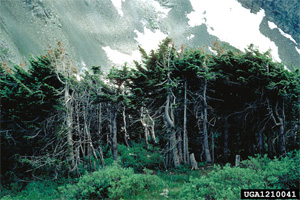|
The process of succession is a combination of different scales and processes within a broad geographic framework where no two successional pathways will be the same due to the diverse regional and local ecosystems present.
The processes and models we have talked about to this point all have a few key factors which influence the processes.
First changes in the abiotic environment are facilitated by the developing community, second invasion of later successional species is only possible following disturbance or by replacing individuals as they die and third late successional species invade because they can tolerate the resource levels available.

Dave Powell, USDA Forest Service, www.forestryimages.org
It should be noted that the model of one single climax or old growth community is inaccurate due to local variations in the environment and the effects of the disturbance regime.
In practice a stable climax community is not found for long periods of time due to the disturbance regime (Barnes et al. 1998).
It is also possible that due to disturbance a community will never develop into a climax community, but instead will be reverted to some other stage of succession.
This process is termed cyclic succession and it may occur on scales ranging from a single tree creating a gap to entire forest communities (Barnes et al. 1998).
|
